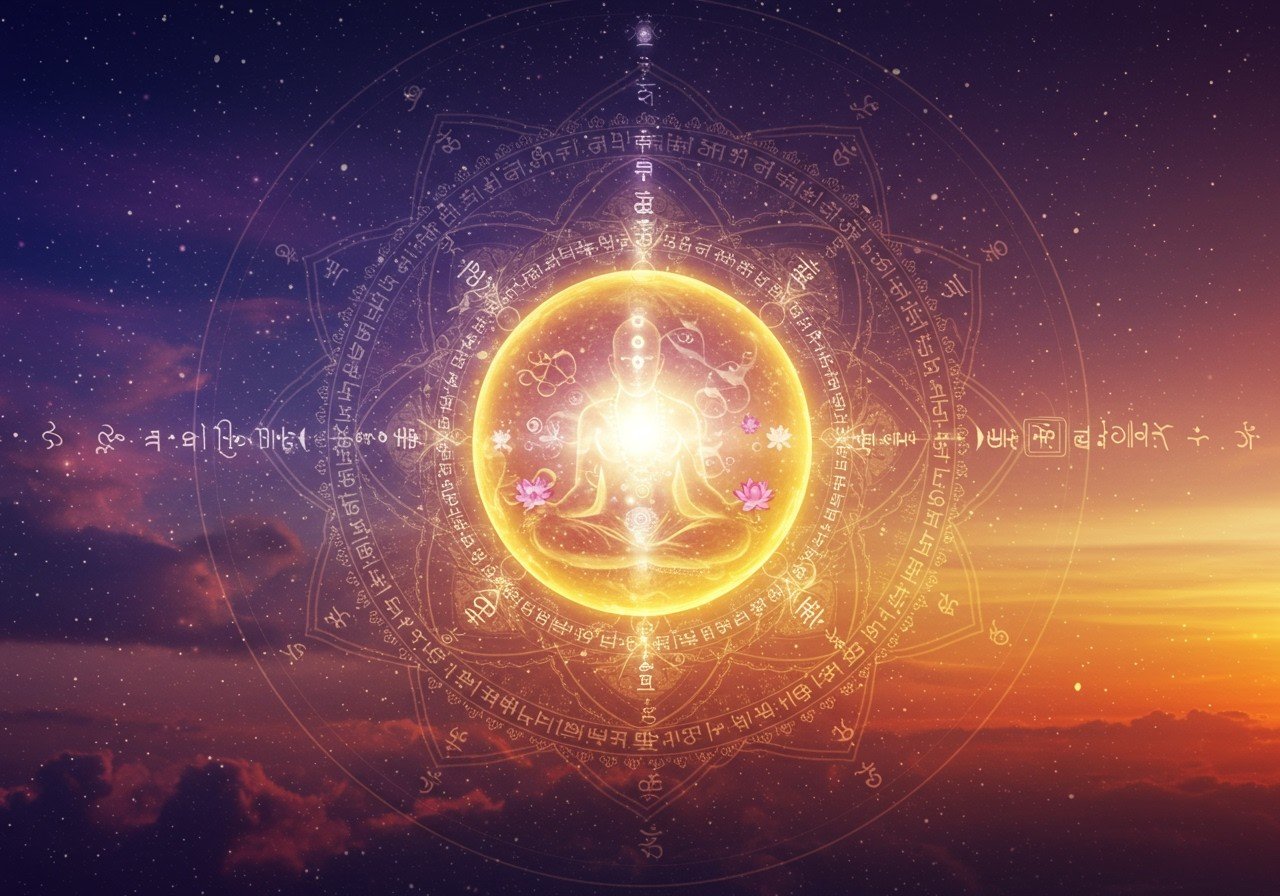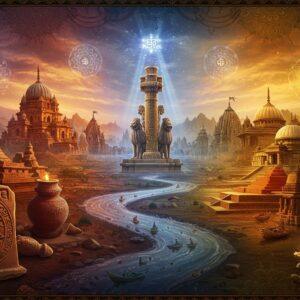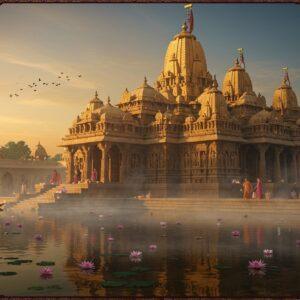
Brahman is a central concept in Hindu philosophy, representing the ultimate reality and foundation of all existence. Its origins trace back to the ancient Vedas and Upanishads. Brahman constitutes the fundamental reality that transcends the duality of existence and non-existence. It serves as the absolute ground from which time, space, and natural law emerge. Brahman represents an unchanging, eternal principle that exists beyond all boundaries and constraints and defies complete description or categorization through language. The significance of Brahman varies across different schools of Hindu thought, such as Advaita Vedanta, Vishishtadvaita, and Dvaita. Exploring Brahman helps us understand Hindu beliefs and practices deeply, as it embodies the idea of interconnectedness and oneness.
Brahman for Kids
Explaining Brahman to children can be simple yet meaningful. Think of Brahman as an “invisible thread” that connects everything, like air or space that we can’t see but know is everywhere. It’s similar to how we feel energy or love—felt but not visible. This helps kids understand unity and harmony in diversity.
- Use stories from Hindu mythology to relate the concept, such as tales of Lord Krishna and his universal presence. Explore books and resources that present these stories in a child-friendly way.
- Describe Brahman as the force that makes everything work together, from the smallest insects to the largest stars. Encourage children to look for connections in nature and their surroundings.
- Create activities like drawing a web to show how everything is connected, from their family and friends to the environment. Use creative play to solidify this concept.
Parents can discuss these ideas using everyday examples, fostering a sense of wonder and respect for all beings. This sets a foundation for lifelong learning about spirituality.
What is Brahman Like?
Brahman is an intriguing concept in Hindu philosophy. It is described through three main qualities: Sat, Chit, and Ananda. Sat means existence—something that always is. Chit stands for consciousness—awareness that lights up everything. Ananda represents bliss—pure joy without any cause.
In Hindu texts, Brahman is depicted in two ways: Nirguna and Saguna. Nirguna Brahman is without any attributes, beyond form and shape. It’s like the calm ocean—vast and limitless. On the other hand, Saguna Brahman has attributes, helping us imagine the unimaginable. Think of it as sunlight through a window, making everything visible.
Brahman transcends time and space, meaning it is everywhere and everywhen. It is eternal, like the endless sky. Yet, Brahman is also immanent, existing within us and around us, much like how water fills a pond. This duality emphasizes Brahman’s pervasive nature.
To help visualize Brahman, Hindu literature uses symbols like light or space. These metaphors guide our understanding of something so profound. Spiritual practices and meditations aim to help individuals experience this reality. Through such practices, one might feel a sense of unity with the universe.
What Does Brahman Look Like?
Visualizing Brahman can be challenging due to its abstract nature. Hinduism uses deities and icons to symbolize Brahman’s attributes. These forms aid in worship and meditation, making the divine more relatable. For instance, Lord Krishna is often seen as an embodiment of Brahman’s qualities.
Murtis (idols) and yantras (geometric symbols) are common tools in Hindu practice. They serve as tangible representations of Brahman’s presence, facilitating connection with the divine. In temples, you can see diverse forms and representations, reflecting Brahman’s omnipresence in life and nature. Poojn.in offers a wide variety of Murtis and Yantras for your spiritual practice. Explore our collection of brass Murtis here.
Artists have depicted Brahman in various ways across cultures and times. Their interpretations show diverse perspectives on this universal principle. Symbolism plays a crucial role in understanding Brahman. The Om symbol, for instance, represents the sound of the universe, embodying the essence of Brahman. Find beautiful Om symbols and other spiritual items at Poojn.in.
Philosophically, some debate whether Brahman can truly be visualized by the human mind. Yet, personal experiences often lead to unique interpretations of Brahman, shaping one’s spiritual journey.
Relevance of Brahman in Daily Life
Understanding Brahman holds practical implications for daily life. Realizing Brahman can bring inner peace and contentment, enhancing mental well-being. This concept promotes universal love and compassion, encouraging kindness and empathy towards others. By recognizing our connection to Brahman, we foster harmony within ourselves and with the world around us.
Recognizing the oneness of all existence, a core principle of Brahman, influences ethical decision-making. It fosters a sense of environmental responsibility and respect for nature. This understanding encourages us to make choices that benefit all beings, not just ourselves. Embracing Brahman’s principles supports a balanced lifestyle, blending spirituality with daily routines. This integration helps us live with purpose and mindfulness.
Mindfulness and meditation practices align with Brahman’s ideals. They offer paths to connect with this ultimate reality. You can find resources and tools for meditation on Poojn.in. Hindu festivals and rituals celebrate Brahman’s presence in the world, reinforcing its significance. These celebrations offer opportunities to connect with our spiritual heritage.
Individuals find personal growth through understanding Brahman. This journey leads to transformation, shaping their worldview and approach to life. It encourages self-reflection and a deeper understanding of our place in the universe.
How Poojn.in Supports Your Spiritual Journey
At Poojn.in, we offer a wide selection of products to support your spiritual journey and deepen your understanding of Brahman and Hindu practices. Our collection includes:
- Pure copper and brass items for sacred rituals, crafted with traditional methods to enhance your spiritual experience. Our items are designed to create a sacred space for your practice.
- Traditional prayer beads (mala) for meditation and chanting, made with natural materials and blessed for purity. These malas are perfect for deepening your meditation practice.
- Authentic Vedic texts and spiritual books about Brahman, curated to provide valuable insights into Hindu philosophy. Explore our collection to enhance your understanding.
Visit Poojn.in today to explore our complete collection and enhance your spiritual practice.
Embracing the Journey to Understanding Brahman
Understanding Brahman is a profound journey of self-discovery. This exploration connects us to the ultimate reality, enriching our lives with peace and purpose. By exploring Brahman’s qualities – Sat, Chit, and Ananda – we open ourselves to deeper awareness and joy.
Incorporating the understanding of Brahman into our daily lives brings harmony and balance. It encourages us to treat others with kindness and respect the world around us. Through mindfulness and meditation, we draw closer to Brahman, finding unity within ourselves and the universe. Discover a deeper connection with Brahman through our guided meditation resources available at Poojn.in.
This journey is personal and transformative, shaping how we see the world and our place within it. As we continue to learn and explore, Brahman becomes a guiding light, illuminating our path with love, compassion, and understanding.
FAQs on Brahman for Beginners
What is Brahman? Brahman is the ultimate reality in Hindu philosophy, the source of everything that exists. It is beyond human comprehension, existing outside of time and space.
Is Brahman a god? Brahman is not a god in the traditional sense. It is the formless, infinite source from which all gods and the universe emanate. It is more of a principle or consciousness than a deity.
What does Brahman look like? Brahman has no physical form or appearance. It is beyond human perception and cannot be visualized in the way we perceive physical objects.
How is Brahman different from Atman? Brahman is the universal consciousness, while Atman is the individual self or soul. In Hindu philosophy, Atman is considered a part of Brahman, like a drop of water is part of the ocean.


